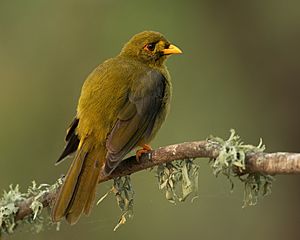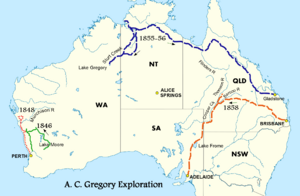Gilburri facts for kids
John Fahy (born March 28, 1814 – died December 23, 1902), also known as Gilburri, was an Irish convict who escaped and lived with the Wakka people in the South-Burnett region of Australia.
Contents
Convict Life in Australia
John Fahy was sent on a ship called the Clyde to Australia in 1838. Many people on the ship were sick with scurvy, a disease caused by not having enough fresh food.
Once in Australia, Fahy was forced to work building roads. He escaped from his work group for the first time on November 11, 1841. He was caught, but he escaped again on April 24, 1842.
Living with Aboriginal People (1842-1854)
On Sunday, April 24, 1842, Fahy escaped for the second time.
Fahy found his way to the Bunya Mountains in January 1843 during a special gathering called the Bunya feast. An Aboriginal group welcomed him and adopted him into their community. They even marked his body with their traditional scars. He lived with them for twelve years.
Important people like Thomas Petrie and Archibald Meston wrote about Gilburri. Meston said that John Fahy was likely the first white man to see the Bunya feasts and ceremonies. He was adopted by the local group, who called him "Gilburri." This name meant "the bell bird."
There is another idea about the name Gilburri. A language expert named Des Crump believes that gil/kil means "to die" or "be dead," and buri means "to come back." This could mean that Gilburri was saved by his adopted Aboriginal father, who believed Fahy was his dead son brought back to life.
Fahy later explained how he was thought to be the return of an old chief's son who had died in battle. The chief said, "Lie down black fella, wake up white fella." Over time, Fahy received the group's traditional body markings and scars. He took the name Gilburri. The bell bird was the special animal (totem) of the dead chief's son, so it also became Gilburri's totem.
John Fahy had red hair, which was considered special among Aboriginal people. Fahy said he lived in lands stretching from Wide Bay to Dalby, and from the Bunya scrub up to Port Curtis.
When the Native Police found him in 1854, Fahy was not wearing clothes. He had special ceremonial marks on his chest and shoulder called "Moolgarra." These marks showed he had been through an important ceremony called Boorool, which is a man-making ceremony in the Bunya country. Fahy spoke highly of the Aboriginal people. He admired their honesty, their love for children, their respect for elders, and their kindness to each other.
He lived with Aboriginal groups in the area between Wide Bay and Dalby. This area was called "Bulduer" by the Aboriginal people. This is the traditional name for Bollier, a place in the Gympie Region.
Fahy understood the different languages spoken by the groups in that area. From the day he escaped until he was caught, he said he never saw another white person or their tracks. He also never heard from the Aboriginal people about any white groups crossing that part of the country.
Fahy was seen near what is now Kenilworth. The people from that part of the Mary River near Gympie were known as the Kabi Kabi people.
Encounters with White Explorers
Russell Meets Fahy (1844)
In 1844, Henry Stuart Russell was exploring the Wide Bay area. He was using a map and information from another escaped convict named Duramboi. Russell's team was deep in the Bunya scrub when they saw about 50 to 60 Aboriginal people. The explorers stopped about 15 meters away. Russell said the group did not move closer or further away. Then, a white man, Gilburri, came forward. To Russell's surprise, Gilburri asked them, "Who are you, white fellow?"
Russell wrote in his diary that Fahy was afraid of being shot. The Aboriginal group he was with had never seen white men before, though they had heard stories about them. Russell's team allowed Fahy to come closer and asked him to tell the others to stay back. The Aboriginal people wanted to be friendly, but Russell's group decided not to interact further. The Aboriginal people then gently moved away without trying to harm them.
Pine River (1846)
Frederick Walker of the Native Police said that "Gilberry is always seen accompanying some of the Mrs Shannon murderers."
Wide Bay (1852)
On December 25, 1852, a newspaper reported that a man named Mr. Robinson was looking for missing sailors. He learned from some Aboriginal people that a white man, called Gilvery, was living with groups further north. Mr. Robinson asked Gilburri to come to Brisbane, warning him that the Native Police would come after him if he did not. Gilburri replied that "he would not come, and did not care for the Native Police." He suggested that he and the Aboriginal people could easily avoid them by going into the Bunya Scrub. He was described as a tall and strong man without clothing.
Captured by Native Police (1854)
One evening, Lieutenant Bligh of the Native Police and his troopers rode up to a station. They surrounded and handcuffed all the Aboriginal people, including those who worked at the station. They tied them around a large gum tree for the night. Bligh was looking for Gilburri, who was believed to be with Aboriginal people in the Bunya Bunya Scrub, about 16 miles from Barambah Station.
On October 11, 1854, Walker mentioned a clash between the Wide Bay Aboriginal people and the Native Police. This happened when the group resisted the police at Obi Creek. The reason for the clash was unknown at first. Walker later found out that the real reason was to stop the police from seeing Gilburri, the runaway convict. Walker had planned to capture him. It seemed strange to Walker that no police patrols had found Gilburri's tracks, as a white man's tracks are different from an Aboriginal person's. However, this was explained because some of the women would follow Gilburri and cover his tracks.
On December 20, 1854, Sub-Lieutenant Bligh reported that he had found Fahy. Bligh had received information that Fahy was camped with Aboriginal people at Ubee Ubee flats near the Mary River. This was sixteen miles from Barambah Station. Bligh searched the camp and found him. He took Fahy to Brisbane and handed him over to the police there. John Fahy did not speak English for two days after his capture.
John O'Connell Bligh noted in December 1854 that "John Fahy was very difficult to track as his women would cover his footprints. He was always seen accompanying the murderers of Mrs. Shannon."
Arthur E. Halloran, the Chief Commissioner of Lands, mentioned Gilburri in his 1854 report on Aboriginal people. He wrote that during his journey to inspect land, in a distant area, Gilburri was captured by Lieutenant Bligh and his Native Police. Gilburri had been living among the Aboriginal people for fifteen years. His capture caused great excitement among the Aboriginal people, who stayed near the police in large numbers on the mountains during their stay.
A.C. Gregory Expedition (1855-1856)
Fahy was sentenced to 12 months of hard labor for escaping in 1842. After three months, explorer A.C. Gregory offered him a pardon if he would act as a guide. Gregory was planning an expedition to find Ludwig Leichhardt and explore the northern part of Australia. Fahy accepted the offer and was released from Cockatoo Island. He left for Brisbane with Gregory on July 18, 1855.
A newspaper article mentioned that "There is also a man named FAHY, a prisoner from Cockatoo Island, who is expected to be useful. It may be remembered that this man was for a long time living in a state of barbarism with the aboriginal blacks, in the neighbourhood of the Bunya Mountains, and that he was captured by Lieutenant BLIGH, of the Native Police."
Gregory only mentioned Fahy a few times in his journal:
- November 19, 1855: "Fahey is on the sick list."
- November 21, 1855: "Fahey, being convalescent (getting better), was employed as cook."
- April 2, 1856: "At 6:45 am started from the depot with Messrs. H. Gregory, Baines, and John Fahey, taking four riding and two pack horses, carrying eighteen days' rations, etc."
- April 5, 1856: "Fahey obtained a large quantity of mussels from the pools in the creek; they proved an excellent addition to our supper, though rather deficient in flavour."
- May 19, 1856: "Fahey and Selby burning charcoal and general camp duties."
Pardoned (1857)
John Fahy received a full pardon on April 27, 1857. This meant he was forgiven for his crimes. The only condition was that he could not return to Ireland or England.
Images for kids







